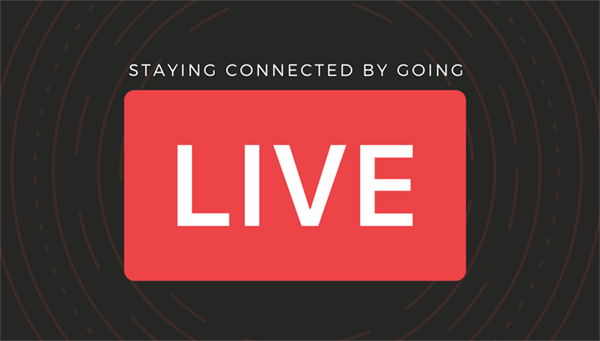
5 Tips for “Going Live” to Stay Connected with Your Customers

The world is in a strange spot right now. The situation surrounding COVID-19 changes every day, and it’s hard to say when things may go back to “normal.” Many businesses are struggling to find ways to stay connected to their customers, even while their doors remain closed. Maybe you can relate.
Good news! The doors of social media are always open, and the amount of people inside is more abundant than ever. Your audience is turning to Facebook and Instagram to pass the time, keep in touch with their friends and family, and get updates from their favorite businesses. When they come looking for you, it’s important to make sure you’re there.
Going “live” is a great way to show up for your customers, provide valuable content, and remain relevant. Maybe you’re a restaurant that can host live cooking demonstrations, a beauty salon that can provide live hair and makeup tutorials, or a local artist who can offer live commissions where your customer gets to provide their input in real-time.
Think outside of the box about how your business can go live and turn to the tips below to do it successfully.
Choosing the Right Device
When going live on Instagram, the only device you can use is your mobile phone. We highly recommend using a tripod that’s compatible with your model of phone, so it’s held level and in place. These can be purchased inexpensively on Amazon.
Depending on age and camera quality, a computer with a webcam would be the recommended device to use for going live on Facebook. The video will be in landscape orientation (the recommended orientation for videos based on user experience). There are also additional options for interactions that will make the live video a better user experience and promote engagement.
Ensuring the Ideal Environment
Wi-Fi Connection
A stable Wi-Fi connection is required to go live. Make sure you are connected to Wi-Fi or using a hot spot (metal roofs and other external factors may affect connection).
Lighting
Lighting is critical with video, just as it is with pictures. Try to film away from windows or direct sunlight (or at least not facing them) and in well-lit areas. Especially keep this in mind for the evening when outside lighting might not be readily available. Depending on your device settings, a ‘Lo-Lux’ or low light setting may be available to allow for filming in darker environments. If you’re shooting in a dark place, you’ll want to set up some additional lighting, so everything in your video is easy to see. Solutions can range from turning additional lights on to purchasing an actual video lighting kit.
Sound
It’s essential to ensure ahead of time that your audio will be clear and easily heard through the live broadcast. Ensure the background is as quiet as possible. Locate the mic on your device and make sure that device placement does not obstruct the mic. Be sure to speak clearly and project in the direction of the microphone. Find your microphone settings on your device, test quality, and make any necessary adjustments in advance. If you find that your device microphone is insufficient for your broadcast, an external microphone may be required. There are a variety of external microphones, including many with Bluetooth capabilities, on the market at different price points.
Test It All
Take a test video in the location that you’re going to go live. You can detect and correct any issues with device placement, background, lighting, internet connection, or audio.
Informing Your Audience
You want to make sure your audience knows when and why you’ll be going live so they can plan on joining. Include the topic, date, time, and any cost or payment information if applicable in your communications.
Get the word out ahead of time on your social channel with posts, stories, sharing to relevant groups, and creating a Facebook event. Don’t be afraid to promote across channels – even if you’re only going live on Instagram, you can promote it on your Facebook channel, and vice versa. Ask your followers to share with any of their friends they think may be interested.
If your website has a popup feature or an events page, utilize those tools as well to inform your audience. That list of previous customer emails you have will come in handy – send out a mass email invitation to join your live session. Particularly loyal or frequent customers could also be candidates for a personal phone call or email to show that you’re thinking of them.
Creating an Outline
Draft an outline and perform a run-through so that you know what to expect for timing. Write out notes or bullet points to help keep you on track and ensure that you communicate everything you intended.
Your outline should include a short intro. It may take users a few minutes to realize you’re live and join. Take this time to welcome guests and thank them for joining you, lay out your plans for the live session, and provide any instructions to your audience.
Keep your tone in mind. Your video should be friendly and interactive like you’re having a conversation.
Interacting with Viewers
As you go through your outline, make sure to pause and make time to interact and engage with viewers.
For Facebook Live, another reason that we highly recommend using a computer with webcam is the ability for better interactions and engagements with your audience.
- Reactions (like love, haha, wow, sad, angry) – viewers will be able to “react” in real-time, and these will come across on the live video.
- Comments – viewers will be able to comment in real-time. It will be easier to read on a computer, rather than a mobile or tablet device.
- Polls – using a computer (not available on mobile), you can set up questions in advance for viewers to answer during the live broadcast. These polls or questions can have up to 4 answer options.
On Instagram Live, you’ll see as new users join, and live comments will appear as well.
Recommendations for Interactions
- Address how many live viewers you have and thank them for joining by name, especially any names you recognize.
- Respond to comments or questions during your live broadcast. If there are more questions than you can answer in the given timeframe, tell viewers to message you directly after the live video ends.
- Ask questions of your audience related to your topic and strike up conversations based on their answers.
Going live now, and even in the future as business reopens, is a great feature to utilize for connecting with your audience from afar. We hope the tips and tools we provided will assist you. We’re always here to help if you need more guidance – click here to get in touch.
You May Like

The Importance of Setting Goals - for Career Success
Recently we had the opportunity to attend The Blue Chip Awards Luncheon. A wonderful afternoon filled with successful small business people, great food and inspirational stories, the highlight was key speaker, Nikki Stone. An Olympic gold medalist, Nikki overcame much adversity and physical challenges throughout her career and stressed the

Public Relations Strategy - 10 Steps to Ensure Success
As many of you know, I earned my APR (Accreditation in Public Relations) last year. Quite the process, I learned far more than I thought via studying assigned literature. One such piece, Cutlip & Center's Effective Public Relations 10th edition (EPR 10) was invaluable. Having practiced public relations for large

Networking: For Business and PR
Networking and communication used to take the traditional path of print advertising and brochures, direct mail, local/national trade shows, etc. These forms of communicating your brand/business still exist but more often they are used in balance with modern forms of networking and sharing information about you and your business. Here